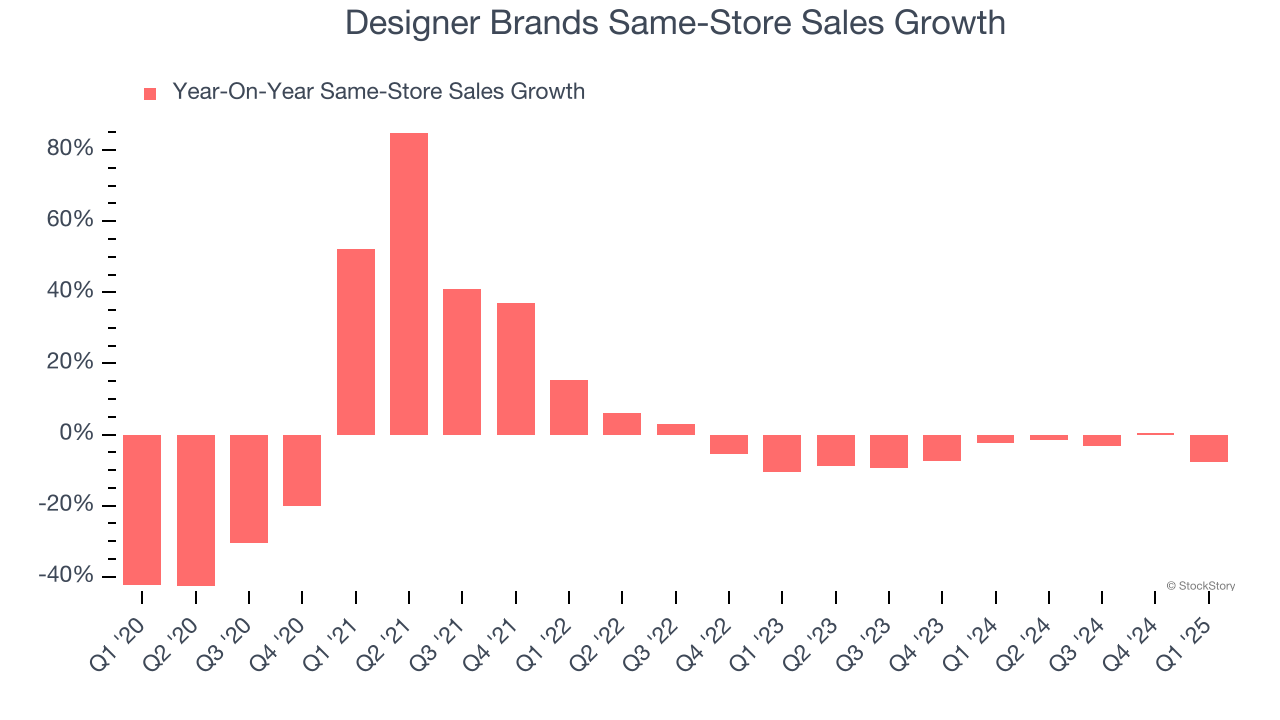
Footwear and accessories discount retailer Designer Brands (NYSE:DBI) missed Wall Street’s revenue expectations in Q1 CY2025, with sales falling 8% year on year to $686.9 million. Its non-GAAP loss of $0.26 per share was significantly below analysts’ consensus estimates.
Is now the time to buy Designer Brands? Find out by accessing our full research report, it’s free.
Designer Brands (DBI) Q1 CY2025 Highlights:
- Revenue: $686.9 million vs analyst estimates of $732.9 million (8% year-on-year decline, 6.3% miss)
- Adjusted EPS: -$0.26 vs analyst estimates of -$0.06 (significant miss)
- Operating Margin: -1.1%, down from 1.3% in the same quarter last year
- Locations: 669 at quarter end, down from 675 in the same quarter last year
- Same-Store Sales fell 7.8% year on year (-2.5% in the same quarter last year)
- Market Capitalization: $181.4 million
"We experienced a soft start to 2025 amid an unpredictable macro environment and deteriorating consumer sentiment," stated Doug Howe, Chief Executive Officer.
Company Overview
Founded in 1969 as a shoe importer and distributor, Designer Brands (NYSE:DBI) is an American discount retailer focused on footwear and accessories.
Sales Growth
A company’s long-term sales performance can indicate its overall quality. Any business can have short-term success, but a top-tier one grows for years.
With $2.95 billion in revenue over the past 12 months, Designer Brands is a small retailer, which sometimes brings disadvantages compared to larger competitors benefiting from economies of scale and negotiating leverage with suppliers.
As you can see below, Designer Brands struggled to generate demand over the last six years (we compare to 2019 to normalize for COVID-19 impacts). Its sales dropped by 2.1% annually despite opening new stores. This implies its underperformance was driven by lower sales at existing, established locations.

This quarter, Designer Brands missed Wall Street’s estimates and reported a rather uninspiring 8% year-on-year revenue decline, generating $686.9 million of revenue.
Looking ahead, sell-side analysts expect revenue to grow 3.4% over the next 12 months, an acceleration versus the last six years. This projection is above average for the sector and suggests its newer products will fuel better top-line performance.
Software is eating the world and there is virtually no industry left that has been untouched by it. That drives increasing demand for tools helping software developers do their jobs, whether it be monitoring critical cloud infrastructure, integrating audio and video functionality, or ensuring smooth content streaming. Click here to access a free report on our 3 favorite stocks to play this generational megatrend.
Store Performance
Number of Stores
Designer Brands operated 669 locations in the latest quarter. It has opened new stores quickly over the last two years, averaging 2.5% annual growth, faster than the broader consumer retail sector.
When a retailer opens new stores, it usually means it’s investing for growth because demand is greater than supply, especially in areas where consumers may not have a store within reasonable driving distance.

Same-Store Sales
The change in a company's store base only tells one side of the story. The other is the performance of its existing locations and e-commerce sales, which informs management teams whether they should expand or downsize their physical footprints. Same-store sales is an industry measure of whether revenue is growing at those existing stores and is driven by customer visits (often called traffic) and the average spending per customer (ticket).
Designer Brands’s demand has been shrinking over the last two years as its same-store sales have averaged 5% annual declines. This performance is concerning - it shows Designer Brands artificially boosts its revenue by building new stores. We’d like to see a company’s same-store sales rise before it takes on the costly, capital-intensive endeavor of expanding its store base.

In the latest quarter, Designer Brands’s same-store sales fell by 7.8% year on year. This decrease represents a further deceleration from its historical levels. We hope the business can get back on track.
Key Takeaways from Designer Brands’s Q1 Results
We struggled to find many positives in these results. Its revenue missed and its EPS fell short of Wall Street’s estimates. Overall, this was a weaker quarter. The stock traded down 21% to $2.93 immediately after reporting.
Designer Brands didn’t show it’s best hand this quarter, but does that create an opportunity to buy the stock right now? The latest quarter does matter, but not nearly as much as longer-term fundamentals and valuation, when deciding if the stock is a buy. We cover that in our actionable full research report which you can read here, it’s free.
